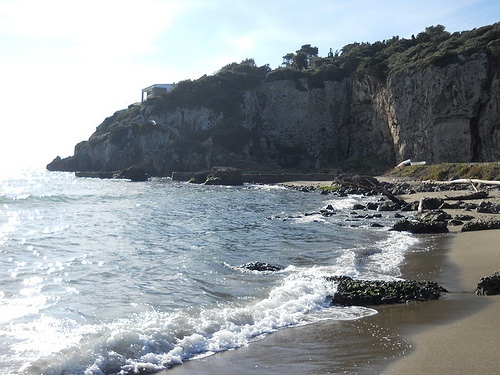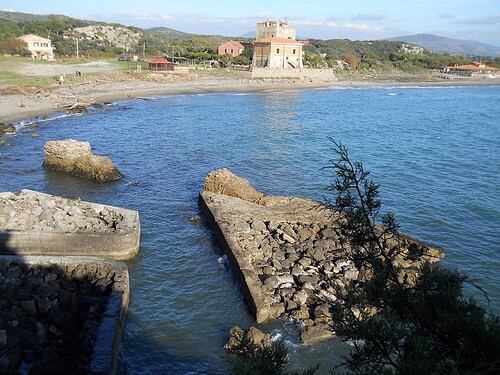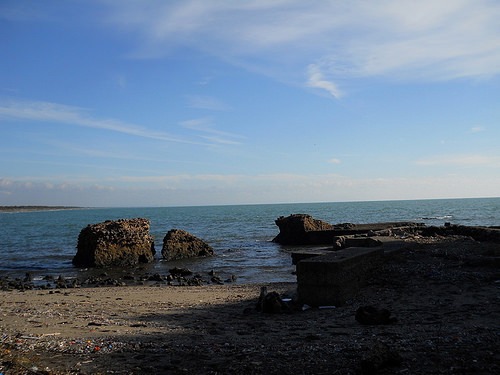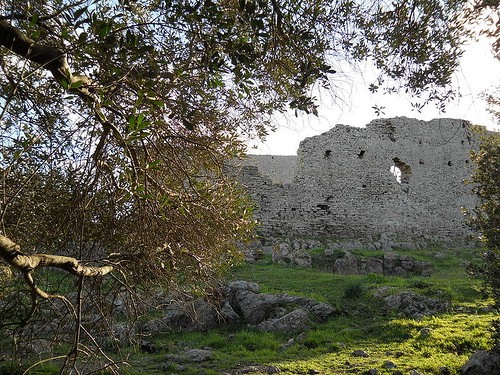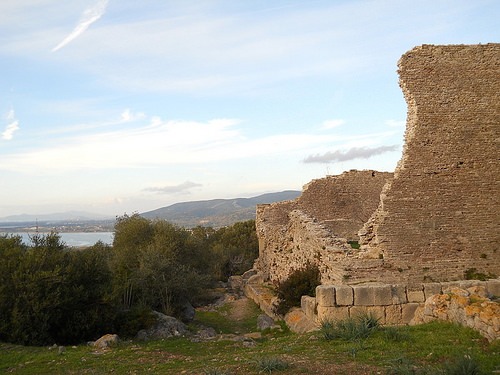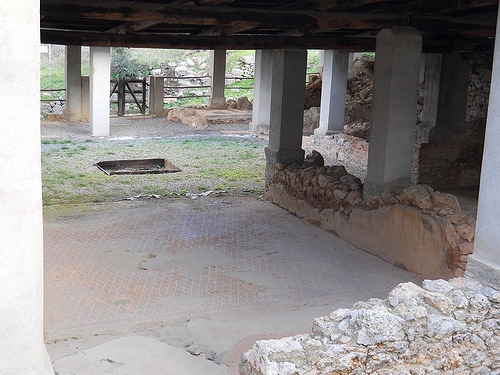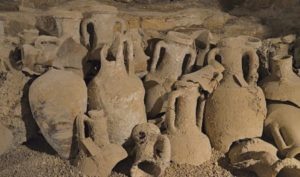
Today there is great silence on the hilltop overlooking the Ansedonia promontory. Here lie the ruins of the ancient Roman town of Cosa. Looking down from this place, one sees the glistening Tyrrenian Sea, whose light breeze caresses the leaves of thousand-year-old olive trees and wafts up the smell of wild flowers. It isn’t easy to imagine how different this sanctuary of peace and meditation was many centuries ago. In fact, in the second century BCE this was a busy place, bustling with activity made possible by slave labor: wine-making, manufacturing amphorae, and wine shipping were its activities. Since before the eighth century BCE, the wine trade had been mainly a Greek and Etruscan business. But after Rome’s 241 BCE conquest of the so-called ‘Granary of Rome’—Sicily — the Romans had the chance to become wine-making entrepreneurs, cultivating a product much more profitable than that of the necessary, but less lucrative, wheat. The Greek wine business was small in comparison with what the Romans had in mind.
As a first step, Rome relocated the production zone to Tuscany from their highly praised vineyards around Naples. Cosa was some 200 miles further north, and had more fertile land, but it couldn’t produce wines that could compete with the full-bodied Falernian and its high alcohol content, which the home market demanded. Nevertheless, coastal Tuscany’s vineyards were deemed a good-enough quality. But above all, its output was enormously greater.
Cosa’s huge vineyards were owned by senatorial families, the most powerful of them being the Sestius family. However, the Sestius estate went well beyond growing grapes; it was a full-cycle organization. In addition to cultivating the vineyards and vinting the wine according to buyers’ tastes, a slave-run factory produced amphorae from local clay. These were then filled with wine, sealed, and transported to a nearby harbour of Etruscan origins—Portus Cosanus—with its new, complex canal system to keep it free of sand. There, hundreds of workers loaded ships with amphorae by the thousands.
___________________________________
Cosa: South view of harbor. In the background: remains of Roman port. Photo by Ugo Venturoli
____________________________________
Port of Cosa from above: on the left Roman masonry, at center mouth of one of the Roman drain canals dug to avoid sanding of port. Photo by Ugo Venturoli
________________________________________
Port of Cosa (Portus Cosanus): on the left the remains of Roman masonry. Photo by Ugo Venturoli
_____________________________________
The Sestius family was not only in business to vint wine and mass-produce amphorae, but to ship that wine to the consumer as well, by sea and by land. It’s not known if they used family owned ships, or simply contracted with maritime enterprises. Amphorae bearing SES on their necks, for SEStius, have been found all over Roman territory. But at least 70 percent of Roman wine from Cosa was bound to ports in what is now southern France. Researchers have calculated that from the beginning of the second to the early decades of the first century BCE, no less than 400,000 amphorae a year were exported to Gaul alone! Romans mainly used the Dressel type1 amphora for shipping by sea. That type had a 25-liter capacity (5 1/2 gallons), which means that, during that century Romans sent Gaul a billion liters of wine (264,172,000 gallons). These imposing numbers are estimates based on the 60 to 80 sunken mercantile wine shipwrecks discovered in the Mediterranean. Their loads are often almost undamaged, so it’s possible to have a precise idea of what this trade was like. The medium-tonnage wine ships weren’t small vessels; they were normally 40 meters or more in length. Each ship could carry up to 3,000 amphorae, piled in layers—a payload of 150 tons. These vessels had been designed purely for coastal navigation. So, when heavily laden, they were unable to withstand open ocean conditions. Their inability to sail safely in heavy seas is evident from the presence of multiple wrecks in relatively confined areas of the sometimes rough Mediterranean Sea, within the windiest reaches. Owing to their round keels and square rigging, they were unfit for sailing into the wind—a serious drawback for northbound ships facing northerly prevailing winds. The poorly suited coastal vessels couldn’t wait for southerly winds that would have enabled a fast broad reach. The south winds, called Vulturnus, occur on average only 4 to 6 days a month. So how did Roman wine get safely and handily across the dangerous Gulf of Lions off Southern France, carrying the incredible quantity of wine the Gauls were craving?
___________________________________
At center (left lower side covered by the net) Dressel type 1 amphora of Cosa manufacture. Very strong and thick; could be piled up to 5 layers on wine-carriers. Photo by Ugo Venturoli, exhibit at Cosa Museum
_________________________________________________________
Section of Roman shipwreck, showing the Dressel type 1 amphorae load piled in layers. Note the amphorae handles positioned lengthwise to avoid breakage. Photo by Ugo Venturoli, image illustration at Cosa Museum.
__________________________________________
In the decade after 1972 French archaeologists André Tchernia and Patrice Pomey had the opportunity to study the wreck of a previously unknown kind of wine-ship. Discovered in 1967 near Toulon by scuba divers of the Ecole de plongée de la Marine Nationale (National Navy Diving School), this shipwreck yielded a definitive answer regarding Rome’s ability to sail windward in the moderate gale conditions frequent in the Gulf of Lions. Named for its place of discovery, the “wreck of Madrague de Giens” lies beneath about 20 meters of water, and sank between about 75 and 50 BCE. Its 40–45-meter length and 500-ton displacement meant that it could carry 8,000 amphorae, in five layers: a payload of around 400 tons. This shipwreck’s discovery marked a turning point in the study of Roman nautical construction and seamanship. Since windward performance was a prime consideration in the Gulf of Lions, this new kind of ship was not only cleverly designed and sturdily built, but it also boasted design innovations meant specifically for the voyage to Gaul: a deep keel with a centerboard-like action for sailing closer to the wind, two masts with a large artemon sail (dolon) to make tacking easier, and a reverse sharp bow to improve sea-worthiness. Nonetheless, although ingeniously designed for the Gulf of Lion weather, this ship sank. Perhaps the sinking had nothing to do with its design. It may have been a simple mistake, perhaps while tacking in a strong gust: the boat heeled too much and was swamped.
The Mandrague de Giens wreck wasn’t connected with the Sestius family organization, but there is good reason to think that such vessels did make up part of the merchant fleet sailing out of Cosa. Whether or not ships of this kind were in the service of the Sestius family, the family shipped huge quantities to what is now southern France. Confirmation comes from a group of French diver-archaeologists, who for more than 25 years studied a different shipwreck, found in 1952 in the Gulf of Marseille, at a depth of 45 meters. It’s name is the “Wreck of Gran Conglué 2,” after the island of its discovery. A very complex archaeological site, it was eventually revealed to be two shipwrecks, one of which was loaded with more than 1,000 amphorae bearing the SES trademark from Roman Cosa.
Roman wine wasn’t a cheap commodity in Gaul. Its consumption was evidently a status symbol. This is made clear by archaeological excavations in far away Corent—almost in the geographic center of France—near the ill-fated town of Gergovie (Gergouia), home of Vercigertorix, the chief of Gaul’s rebellion. Fragments of more than 40 tons of amphorae were used as a paving material for the houses of rich Gauls. This amphora pavement stands as material evidence of ostentation, a symbol of opulence, because of the volume and value of the wine consumed to have produced so many empty amphorae. Use of wine amphorae as paving material aslo gives us information about the inclination and economic power of the Gauls to allocate huge resources for a product of constantly increasing profitability for the Romans. Moreover, only the lure of vast profits can explain the presence of enterprising Roman wine traders in a hostile region, well beyond the protection that Roman legions provided in the occupied areas of southern Gaul.
In the monumental Bibliotheca historica about the habits of the Gauls, Greek historian Diodorus Siculus describes the relationship between wine and the Gauls:
They like beyond any reasonable measure the wine imported by merchants and they drink it straight[1] and they are so avid of this drink that they get drunk and fall asleep or assume insane and furious attitudes.
For this reason many merchants from Italy, with their usual lust for money, think that this Gauls propensity is a gift given to them by the God of commerce.
So, importing more wine on river waterways, or through the plains making use of vehicles, they make an incredible amount money: giving one amphora of wine they get in exchange a youth, a slave being so the compensation for the drink. [2]
With the manifold interests it involved, the Roman wine trade was a business unlike any other. Eventually, Rome’s merchant presence in Gaul came to an abrupt and brutal end. On February 13th, 53 BCE, in Cenabum, today’s Orléans, all the Roman merchants were massacred. Julius Caesar gives a brief report of the deed in his first-hand account of the Gallic Wars, Commentarii de Bello Gallico:
When that day arrived, the Carnutes . . . at a given signal fell upon Cenabum and killed the Roman citizens who had settled there for reasons of trade, . . . sacking their goods.[3]
Other than political motivations, Caesar says nothing about what else might have caused this extreme Gallic reaction to Roman mercantile penetration. Clearly, Caesar was well aware of the debilitating effects that strong Roman wine could have on populations—such as the Gauls—accustomed to a low-alcohol drink like beer.
In a less well-known passage of de Bello Gallico, Caesar writes about the Suebi:
They do not allow at all the importation of wine, because they think that, in order to endure hard work, it softens and effeminates men. [4]
With written evidence of a social backlash to wine’s negative effects, it seems reasonable to suppose that the massacre of Roman traders at Cenabum grew out of a hostile attitude on the part of influential Gauls towards the intoxicating and habit-forming properties of the Roman beverage.
Referring to the Gallic insurgency that began at Cenabum, French historian Fernand Braudel[5] dares this comment after quoting the Diodorus Siculus passage above:
Here we have something which calls to our mind the dope traffic which today brings so many benefits to the intermediaries, the transporters, the distributors and, finally, to the poppy cultivators in the Far East (1986).
After the Cenabum massacre, perhaps to continue imposing wine on a susceptible population, Caesar tightened the vise of his legions on the Gauls. In September, 52 BCE, in Alésia, today’s Alise St. Reine in the heart of Burgundy, the rebellion against the Romans was crushed, Vercingetorix surrendered and, brought to Rome as a prisoner, later executed.
The fight continued for some months, but before the end of 51 BCE, after seven years of intermittent war, the entire region of Gaul was pacified. This Pax Romana (Roman peace), according to Plutarch, cost Gaul over a million dead, and a million natives of both sexes reduced to slavery.
Roman wine traders could continue their profitable work.
The first commercial conquest in history was complete.
__________________________________________________
Photo Gallery
A tunneled canal excavated in the rock to direct the evacuated sand to the sea. Photo by Ugo Venturoli.
Castings of neck markings of Sestius family amphoras. Symbols after letters SES indicate: provenance, type of wine, quality, price — much like labels today. Photo by Ugo Venturoli.Photo by Ugo Venturoli.
Artist’s rendering of the ship known as the “wreck of Mandrague de Giens.” CREDIT: Water color by Jean Marie Gassend.
Cosa Capitolium north side. The temple was dedicated to the Capitoline Triad composed of the three supreme deities: Jupiter, Juno, and Minerva. Photo by Ugo Venturoli.
Cosa Forum remains. Photo by Ugo Venturoli.
Capitolium, south side. Photo by Ugo Venturoli.
Skeleton’s house (Roman masonry). Photo by Ugo Venturoli.
Skeleton’s house, mosaic paving. Photo by Ugo Venturoli.
Cosa town walls, north view and north town entryway. Photo by Ugo Venturoli.
___________________________________
Olive tree of Cosa hill, purported to be 1,000 years old. Photo by Ugo Venturoli.
Cover Photo, Top Left: Roman wine amphorae. Carole Raddato, Wikimedia Commons
[1] Romans drank their wine—which usually had an alcohol content of 16% by volume—mixed with water: 1 part wine to two parts water.
[2] “κάτοινοι δ᾽ ὄντες καθ᾽ ὑπερβολὴν τὸν εἰσαγόμενον ὑπὸ τῶν ἐμπόρων οἶνον ἄκρατον ἐμφοροῦνται, καὶ διὰ τὴν ἐπιθυμίαν λάβρῳ χρώμενοι τῷ ποτῷ καὶ μεθυσθέντες εἰς ὕπνον ἢ μανιώδεις διαθέσεις τρέπονται. διὸ καὶ πολλοὶ τῶν Ἰταλικῶν ἐμπόρων διὰ τὴν συνήθη φιλαργυρίαν ἕρμαιον ἡγοῦνται τὴν τῶν Γαλατῶν φιλοινίαν. οὗτοι γὰρ διὰ μὲν τῶν πλωτῶν ποταμῶν πλοίοις, διὰ δὲ τῆς πεδιάδος χώρας ἁμάξαις κομίζοντες τὸν οἶνον, ἀντιλαμβάνουσι τιμῆς πλῆθος ἄπιστον: διδόντες γὰρ οἴνου κεράμιον ἀντιλαμβάνουσι παῖδα, τοῦ πόματος διάκονον ἀμειβόμενοι.”
Diodorus Siculus Bibliotheca Historica 5.26
[3] “Ubi ea dies venit, Carnutes… Cenabum signo dato concurrunt civesque romanos, qui negotiandi causa ibi constiterant,….interficiunt bonaque eorum diripiunt.”
Julius Caesar Commentarii de Bello Gallico 7.3.
[4] “Vinum ad se omnino importari non sinunt, quod ea re ad laborem ferendum remollescere homines atque effeminari arbitrantur.”
Julius Caesar Commentarii de Bello Gallico 4.2.
[5] “Voilà qui fait penser au commerce de la drogue qui, aujourd’hui, favorise tellements les intérmediaires, les trasporteurs, les distributeurs, et au lointain départ, les paysans cultivateurs de pavot, en Extreme-Orient.”
Fernand Braudel, L’Identité de la France (1986), 111.
______________________________________________________

